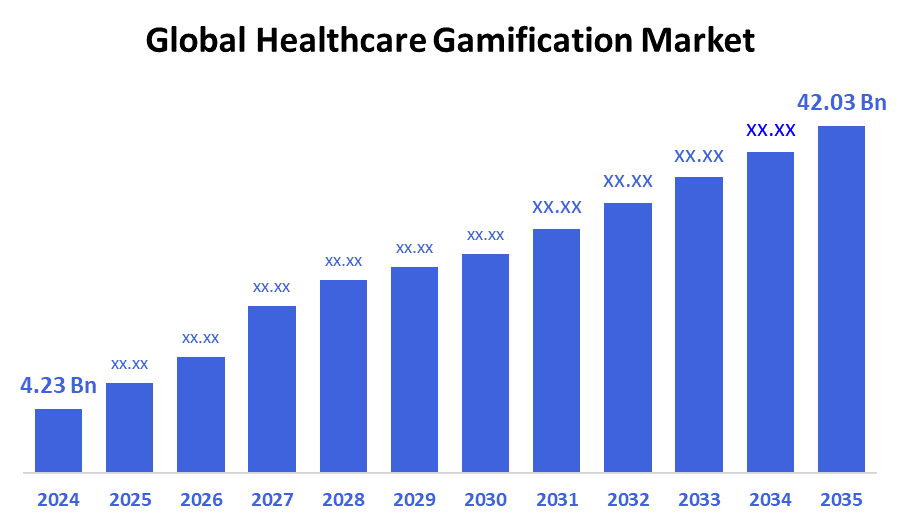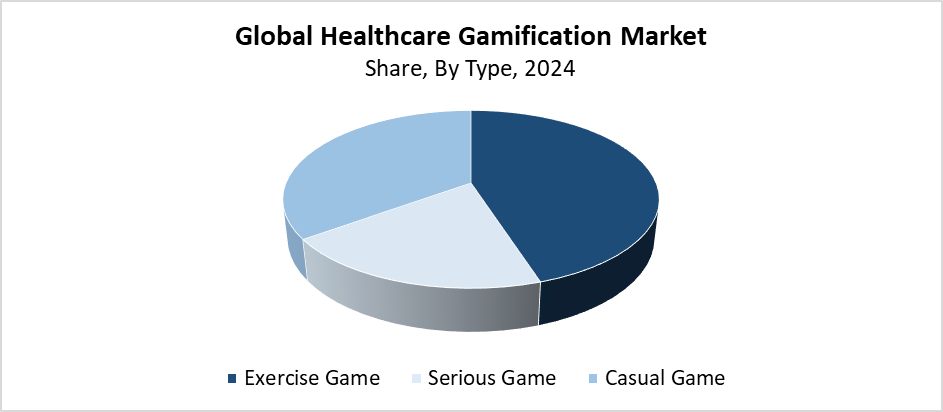Global Healthcare Gamification Market
Global Healthcare Gamification Market Size, Share, and COVID-19 Impact Analysis, By Type (Exercise Game, Serious Game, Casual Game), By End Use (Enterprise Based, Consumer Based), and By Region (North America, Europe, Asia-Pacific, Latin America, Middle East, and Africa), Analysis and Forecast 2025-2035
Report Overview
Table of Contents
Healthcare Gamification Market Summary
The Global Healthcare Gamification Market Size Was Estimated at USD 4.23 Billion in 2024 and is Projected to Reach USD 42.03 Billion by 2035, Growing at a CAGR of 23.21% from 2025 to 2035. The market for healthcare gamification is expanding as a result of rising chronic disease rates, increased patient engagement and adoption of health-focused digital technologies, government initiatives supporting digital health, the COVID-19 pandemic's impact on the adoption of digital health, and technological advancements like AI and IoT integrating with gamified platforms to create personalized health solutions.

Key Regional and Segment-Wise Insights
- With the largest revenue share of 40.27% in 2024, North America led the worldwide healthcare gamification market.
- In 2024, the exercise game segment held the highest revenue share of 45.36% and led the market based on type.
- In 2024, the enterprise-based segment led the market by end-use.
Global Market Forecast and Revenue Outlook
- 2024 Market Size: USD 4.23 Billion
- 2035 Projected Market Size: USD 42.03 Billion
- CAGR (2025-2035): 23.21%
- North America: Largest market in 2024
The healthcare gamification market consists of integrating game mechanics and design elements into healthcare platforms, systems, and applications, which boosts patient involvement and creates better health results and drives behavioral transformation. The market demonstrates strong growth because people are becoming more aware about healthy living benefits along with rising chronic disease rates and growing prevention healthcare focus. Gamification methods use challenges together with progress tracking, rewards, and personalized feedback to motivate people toward healthier habits. The rising usage of smartphones and wearable devices has made gamified health applications, fitness trackers, and wellness platforms more accessible to users. Younger people and users with technical expertise prefer these applications.
Healthcare gamification advancement heavily relies on technological advancements in the field. Modern technologies, including real-time performance tracking alongside AR/VR rehabilitation systems and AI health recommendation systems, boost both user participation and treatment outcomes through gamified methods. The combination of wearable devices with continuous health monitoring creates new possibilities, and mobile platforms guarantee both scalability and user convenience. Government programs that support digital health through telemedicine and mobile health app funding drive increased adoption of these technologies. Public health initiatives leverage game-based approaches to encourage regular health assessments and medication compliance, as well as physical fitness, which leads to worldwide market growth.
Type Insights

The exercise game segment led the healthcare gamification market with the largest revenue share of 45.36% in 2024. The primary factor behind this leadership position stems from the increasing demand for interactive fitness programs that motivate physical activity and healthy lifestyle choices. Exercise games, also known as exergames, combine real-time feedback and obstacles with rewards and game elements to maintain user engagement. Users from every age group find these games attractive because they appear on home workout platforms and fitness apps, and rehabilitation programs. The increased smartphone usage, together with wearable fitness trackers and rising sedentary lifestyles, along with growing health awareness, solidified the market dominance of gamified exercise solutions.
The casual game segment within the healthcare gamification market is expected to grow at a significant rate during the projection period. The growing interest in user-friendly educational games that promote healthy behavior without complicated gaming requirements drives this expansion. Casual games create valuable benefits for medical adherence, mental health promotion, lifestyle betterment, and medical knowledge education. Patient engagement strategies and public health initiatives use casual games because they attract different age groups while working on mobile devices. The casual games market will experience substantial expansion as healthcare providers and developers seek budget-friendly digital health systems that can scale effectively.
End Use Insights
The enterprise-based segment captured the largest revenue share and led the healthcare gamification market in 2024. The growing use of gamified solutions by insurance companies and healthcare organizations, as well as corporate wellness initiatives, drives this market dominance for healthcare cost savings and employee health improvement. Businesses use gamification through wellness challenges and rewards, and health monitoring systems to encourage better health practices and boost patient involvement and workplace results. The rise of gamified platforms has occurred because of healthcare's shift toward prevention and efforts to decrease employee chronic disease management costs. The enterprise segment maintains its market leadership position because businesses continue to adopt these solutions with technological advancements in digital health and increasing recognition of healthcare gamification benefits.
The consumer-based segment of the healthcare gamification market is expected to grow at the fastest CAGR throughout the forecast period. The rising health awareness among people, along with the increasing acceptance of wearable devices featuring game elements and mobile health applications, drives this rapid expansion. Customers seek entertaining yet simple products that enable them to control chronic illness management alongside mental health and physical fitness activities from their home base. Tech-oriented customers find appeal in the personalized experience and ease of use that gamified health solutions provide, including exercise competitions and achievement tracking systems, and reward systems. Adoption continues to increase because of growing self-management interest, preventive healthcare awareness, and worldwide smartphone accessibility.
Regional Insights
In 2024, North America led the global healthcare gamification market with the largest market share of 40.27%. The sophisticated healthcare system in the region, together with its widespread digital health tool adoption and preventive care focus, creates conditions that make it a market leader. The rise of health awareness among consumers, combined with smartphone adoption, wearable technology, and fitness apps, has driven up the popularity of gamified healthcare solutions. The industry expands due to large healthcare innovation funding, together with proactive government initiatives. The leading healthcare gamification position of North America receives additional support from the major market players that operate in the US and Canadian territories, while they maintain active research and development programs.
Asia Pacific Healthcare Gamification Market Trends
The significant expansion of the Asia Pacific healthcare gamification market emerges from rising smartphone penetration and growing health awareness, together with expanding digital healthcare adoption across the region. Various Asian countries, including China, India, Japan, and South Korea, experience increasing interest in gamified health and wellness applications, which address mental health support, physical exercise, and chronic disease monitoring. The market expands because more people move into the middle class while their financial resources increase. Government initiatives that promote digital health progress and better healthcare infrastructure also speed up adoption rates. Technology companies partner with healthcare providers to create region-specific gamified solutions that meet local market requirements.
Europe Healthcare Gamification Market Trends
The healthcare gamification market in Europe grows significantly because of rising public health understanding, along with rising priority for preventive care and digital healthcare systems. Germany, together with the United Kingdom and France, serves as a leading nation that utilizes gamified health solutions to address chronic disease management, mental health, and physical fitness programs. The successful implementation of wellness initiatives and rehabilitation treatments alongside strong digital health technology regulatory support drives the adoption of gamification in the region. Insurance companies, together with healthcare professionals, utilize gamified platforms to boost patient participation and enhance treatment compliance. Europe stands as an emerging market for user-friendly healthcare gamification solutions, which target both consumer and enterprise segments because of its tech-savvy population and increasing focus on healthy lifestyles.
Key Healthcare Gamification Companies:
The following are the leading companies in the healthcare gamification market. These companies collectively hold the largest market share and dictate industry trends.
- Fitbit, Inc.
- Omada Health Inc.
- Mango Health
- Ayogo Health, Inc.
- Microsoft Corporation
- Google LLC
- Akili Interactive Labs, Inc.
- Cognifit, Inc.
- BrainLAB AG
- Medtronic PLC
- Evolv Rehabilitation Technology S.L.
- Nike, Inc.
- GecKoCap
- Others
Recent Developments
- In December 2024, the AI-powered healthcare technology solutions company Ginkgo Health unveiled Ginkgo Active, a comprehensive app made to encourage overall wellness with customized workout regimens.
- In October 2022, Fitbit collaborated with Pretaa, a behavioral analytics firm, to help the millions of Americans who are battling substance abuse.
Market Segment
This study forecasts revenue at global, regional, and country levels from 2020 to 2035. Decision Advisors has segmented the healthcare gamification market based on the below-mentioned segments:
Global Healthcare Gamification Market, By Type
- Exercise Game
- Serious Game
- Casual Game
Global Healthcare Gamification Market, By End Use
- Enterprise Based
- Consumer Based
Global Healthcare Gamification Market, By Regional Analysis
- North America
- US
- Canada
- Mexico
- Europe
- Germany
- UK
- France
- Italy
- Spain
- Russia
- Rest of Europe
- Asia Pacific
- China
- Japan
- India
- South Korea
- Australia
- Rest of Asia Pacific
- South America
- Brazil
- Argentina
- Rest of South America
- Middle East & Africa
- UAE
- Saudi Arabia
- Qatar
- South Africa
- Rest of the Middle East & Africa
Check Licence
Choose the plan that fits you best: Single User, Multi-User, or Enterprise solutions tailored for your needs.
We Have You Covered
- 24/7 Analyst Support
- Clients Across the Globe
- Tailored Insights
- Technology Tracking
- Competitive Intelligence
- Custom Research
- Syndicated Market Studies
- Market Overview
- Market Segmentation
- Growth Drivers
- Market Opportunities
- Regulatory Insights
- Innovation & Sustainability
Report Details
| Pages | 220 |
| Delivery | PDF & Excel via Email |
| Language | English |
| Release | Sep 2025 |
| Access | Download from this page |
